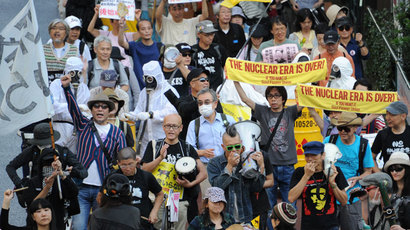Radioactivity level spikes 6,500 times at Fukushima well
Radioactivity levels in a well near a storage tank at the Fukushima nuclear power plant in Japan have risen immensely on Thursday, the plant’s operator has reported.
Officials of the Tokyo Electric Power Company (TEPCO) said on
Friday they detected 400,000 becquerels per liter of beta
ray-emitting radioactive substances - including strontium - at
the site, a level 6,500 times higher than readings taken on
Wednesday, NHK World reported.
The storage tank leaked over 300 tons of contaminated water in
August, some of which is believed to have found its way into the
sea through a ditch.
The well in question is about 10 meters from the tank and was dug
to gauge leakage.
TEPCO said the findings show that radioactive substances like
strontium have reached the groundwater. High levels of tritium,
which transfers much easier in water than strontium, had already
been detected.
Officials at TEPCO said they will remove any contaminated soil
around the storage tank in an effort to monitor radioactivity
levels of the water around the well.
The news comes after it has been reported a powerful typhoon which swept through Japan led to highly radioactive water near the crippled nuclear power plant being released into a nearby drainage ditch, increasing the risk of it flowing into the sea.
On Wednesday TEPCO said it had detected high levels of radiation in a ditch leading to the Pacific Ocean, and that it suspected heavy rains had lifted contaminated soil.
‘Decades-long problems being faced at Fukushima’
Robert Jacobs, a professor at Hiroshima Peace University, told RT the compounding problems at Fukushima Daiichi underscore one critical reality: no one really knows what to do.
“Nobody really knows how to solve the problems at Fukushima. There is nobody who has solutions. The problems at Fukushima are unprecedented, so even bringing in outside expertise, all that they can try to do is problem solve. There is no solution that other countries have that they can come in and fix the reactors, or rather, shut down the contamination, shut down the leaks.”
Experts believe that even a small earthquake could lead to more serious nuclear damage in the area.
“They have a thousand tanks that are held together with a plastic pipe, so if there is a moderate earthquake the plastic pipes will fail and all that material will run across the ground surface and into the ocean,” nuclear power expert Arnold Gundersen told RT.
“Facilities themselves, the four reactors that are the most damaged had a series of explosions internally, so it would not take an earthquake as big as the one they had two and a half years ago to potentially do a lot of serious damage there.”
He added that the health risks are great and continue to increase every year. “Somewhere between 100,000 to 1,000,000 [people] will over the next thirty years get cancer from this accident...1,000 additional cancers a year from eating fish from the Pacific.”
Prime Minister Shinzo Abe’s open request for advanced knowledge from overseas is a welcome step, as this will bring a higher degree of professionalism than Tepco has demonstrated since the crisis first erupted, Jacobs says. But even though, those experts will be at a loss to solve the immense problems they’ll be facing for decades at Fukushima.
Even in the one area where Japan could potentially help contain the disaster, the authorities have wavered, Konstantin Simonov from the Moscow-based Fund for Energy Security told RT.
“Fukushima should be treated just like Chernobyl – as a wreck that must be retired and put in a sarcophagus, with radioactive waste slowly and thoroughly utilized. Why does the problem persist at Fukushima? Because they can’t decide whether they want to close it or to keep it going.”
Tokyo Electric Power Company in fact seems reluctant to shut down Fukushima for good. Tepco is in fact pushing to reopen its Kashiwazaki Kariwa facility – the world's largest nuclear power station – which itself was shut down in 2007 following reports of radioactive leaks in the wake of an earthquake.
In September, Japan announced its only operating nuclear reactor had been closed for maintenance, leaving the country with no nuclear power supply for only the second time in four decades.
Atomic power accounted for 30 percent of Japan’s energy needs prior to the Fukushima disaster, and the country was forced to increase fossil fuel imports to make up for the deficit.
As a result, Japan become the world’s largest importer of liquefied natural gas (LNG), prompting the world’s third-largest-economy to post its first trade deficit since the second oil shock 31 years ago.
Under these circumstances, the crisis gripping Fukushima will not
be the only factor in deciding the fate of the country’s nuclear
industry.














